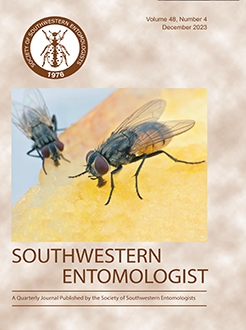Efficacy of entomopathogens for biological control of pests is frequently enhanced by modifying techniques applied in the field. One variation includes use of mixtures of different agents such as bacteria and viruses. In this report, mixtures of a baculovirus (PlxyNPV) and Bacillus thuringiensis Berliner, 1915, strain were tested by analyzing their joint-action effectiveness. Because four strains of B. thuringiensis previously showed important amounts of toxin against diamondback moth larvae, Plutella xylostella Linnaeus, 1758, an initial study selected the most toxic among the four strains. LC50s were compared, and strain LBIT-229 was selected (LC50 =170 ng/cm2) to be tested in mixtures with the baculovirus strain once LC50 for the virus was estimated individually (LC50 =425 ng/cm2). Bioassays with a 3:1 mixture of virus and LBIT-229, respectively, were used at laboratory conditions against P. xylostella 2nd-instar larvae. LC50 of the mixture was estimated at 508 ng/cm2, which was compared with the expected (theoretical) value calculated by the Tabashnik formula. According to fiducial limits from LC50 estimated empirically, both agents had an antagonistic effect. A second joint-action test was used, based on the Tammes-Bakuniak graphical method, and found empirical LC50 in the area of antagonism, corroborating the previous result. Simultaneously, a series of experiments was done using the same mixture in a broccoli (Brassica oleracea Linneaus,1753) field, showing statistical differences among all treatments. Most diamondback moth larvae were killed when the virus was tested alone, followed by areas where the LBIT-229 strain was applied alone. Fewest larvae were killed when a mixture of both agents was tested. Antagonism between strains was clear in the laboratory and in the field.
La eficacia de los agentes entomopatógenos utilizados en el control biológico de insectos plaga, depende de las técnicas aplicadas en el campo, siendo una opción el utilizar mezclas de diferentes agentes, tales como, bacterias y virus. En este trabajo, se probaron mezclas de un baculovirus PlxyNPV y una cepa de Bacillus thuringiensis Berliner, 1915, para evaluar su efectividad hacia Plutella xylostella Linnaeus, 1758, al utilizarse de manera conjunta a nivel de laboratorio y campo. Se evaluaron cuatro cepas de B. thuringiensis que mostraron una alta Actividad bioinsecticida contra las larvas de la palomilla dorso de diamante P. xylostella, y se seleccionó a la cepa más tóxica, la cual resultó ser la cepa LBIT-229 (CL50 = 170 ng/cm2), para probarla mezclada con una cepa de baculovirus PlxyNPV, de la cual, también se estimó su CL50 actuando sola sobre esta plaga, obteniéndose un valor de 425 ng/cm2. Primeramente, se realizaron bioensayos bajo condiciones de laboratorio, con larvas de segundo estadío de P. xylostella, utilizando una proporción de 3:1 de la cepa de virus PlxyNPV y de la bacteria LBIT-229, respectivamente. La CL50 de la mezcla se estimó en 508 ng/cm2, y ésta se comparó con el valor esperado (teórico), el cual se calculó mediante la fórmula de Tabashnik. Según los límites fiduciales de la CL50 estimados empíricamente, ambos agentes tuvieron un efecto antagónico. Se utilizó una segunda prueba de acción conjunta, basada en el método gráfico de Tammes-Bakuniak, y se obtuvo una CL50 empírica, que se ubicó en la zona de antagonismo, corroborando con esto el resultado anterior. Simultáneamente, se realizó una serie de experimentos en un campo de brócoli (Brassica oleracea Linneaus,1753), utilizando la misma mezcla probada a nivel de laboratorio, mostrando diferencias estadísticas entre todos los tratamientos. La mayoría de las larvas de la palomilla dorso de diamante murieron cuando el virus se probó solo, seguidas de las áreas donde se aplicó solamente la cepa de B. thuringiensis LBIT-229. Cuando se probó la mezcla de ambos agentes entomopatógenos, murieron menos larvas. El antagonismo entre ambas cepas de entomopatógenos fue demostrado tanto a nivel de laboratorio como a nivel de campo.





